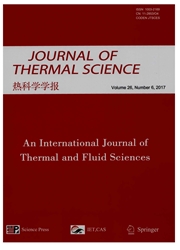

 中文摘要:
中文摘要:
采用降维的方法考察了倾对某单排叶片进口流场的影响,利用进口流场的变化解释了倾改善端壁流动的机理.通过推导周向平均的Navier-Stokes(N-S)方程得到了周向不均匀源项的表达形式.在均匀来流条件下,周向不均匀源项的径向和周向分量在叶片通道前已经存在,表征了进口流场周向不均匀性的强弱.通过对不同倾叶栅模型的三维数值计算和周向平均后处理发现,倾会改变叶片通道进口周向不均匀源项的大小和分布,引发进口气流的径向迁移,其中正倾使进口气流有从叶根到叶尖的迁移趋势,从而可以改善端壁的流动,负倾的作用与之相反.来流马赫数、叶片稠度和安装角等气动设计参数也会对倾叶片进口周向不均匀源项产生影响,过高的来流马赫数和过大的安装角均不利于体现倾对进口流场的作用效果.
 英文摘要:
英文摘要:
The effect of lean on the inlet flow of a single blade row was studied with the dimensionality reduction method, and the mechanism for lean improving endwall condition was explained by the inlet flow change. The circumferential fluctuation (CF) source items were obtained through the derivation of the circumferentially averaged Navier-Stokes (N-S) equations. The radial and circumferential components of the CF sources existed yet before the blade passage with a uniform incoming flow, representing the magnitude of the inlet CF. Different leaned cascade models were numerically calculated and circumferentially averaged. The results indicate that lean could change the magnitude and distribution of the CF source items before the blade passage, leading to the radial migration of the inlet flow. The positive lean diverts the inlet flow from hub to tip and improves the endwall condition, while the negative lean has a contrary effect. The inlet CF sources are also affected by the aerodynamic parameters such as the inlet Math number, blade solid- ity and stagger angle. Neither an over-high inlet Maeh number nor an over-wide stagger angle is good for the effect of blade lean on the inlet flow.
 同期刊论文项目
同期刊论文项目
 同项目期刊论文
同项目期刊论文
 Experimental study of heat transfer characteristic on jet impingement cooling with film extraction f
Experimental study of heat transfer characteristic on jet impingement cooling with film extraction f A Similitude Method and the Corresponding Blade Design of a Low-Speed Large-Scale Axial Compressor R
A Similitude Method and the Corresponding Blade Design of a Low-Speed Large-Scale Axial Compressor R 期刊信息
期刊信息
